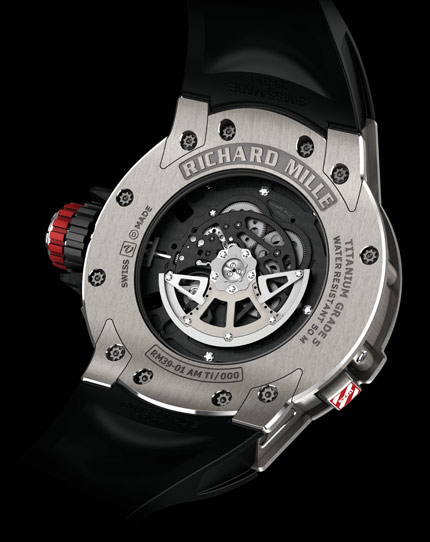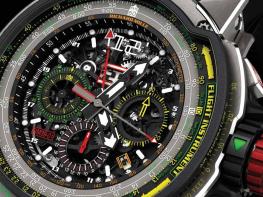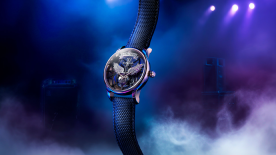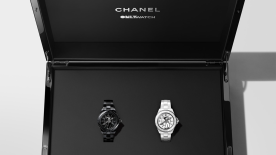Aviation and aeronautics are sources of inspiration for Richard Mille and, as such, materials such as titanium, carbon nanofiber, orthorhombic titanium aluminide, ARCAP and tungsten carbide have all been used in the Richard Mille collection, making the leap from aeronautics to watchmaking. Richard Mille has thus been able to demonstrate the mechanical and aesthetic properties of these materials and prove the legitimacy of their use in the watchmaking world.
The RM 39-01 is the direct descendant of the RM 039 Aviation watch, an ultra-complex tourbillon flyback caliber that contains no fewer than 1,000 components. The RM39-01 movement is designed as a flight navigation instrument. This highly technical and extremely sophisticated watch is a modern interpretation of a device that is essential for any experienced pilot: the E6B slide rule, invented in the 1930s in the United States by Lieutenant Philip Dalton.

The E6B slide rule features a fixed bezel and bi-directional rotating bezel, both marked with several complex indications. It can be used to read and calculate fuel consumption, flight times, ground speed, density altitude and wind influence, and to convert units of measurement (knots/kms/gallons/ litres/ feet/kgs/lbs) quickly. This highly complex bezel required many months of research to ensure easy adjustment as well as optimal visibility of the different calculations and their results.
The new RM 39-01 provides pilots with a practical and rapid instrument for successively timing different durations in a number of directions. They can therefore receive departure signals issued by radio beacons without losing time or having to execute numerous operations on their watches. During flight preparation, the E6B slide rule therefore remains the most accurate device for determining required fuel load and density altitude (essential for take-off and landing). The E6B slide rule requires no power supply, making it an extremely safe-flight instrument for pilots, even today.
The RMAC2 automatic caliber which beats at the heart of the RM 39-01, features UTC and countdown functions, a flyback chronograph, an oversized date at 12 o’clock, a month display and a variable geometry rotor. It has almost 620 components and 62 jewels, with a power reserve of 50 hours. This caliber also comes with a special function-locking mechanism. In order to prevent any accidental in-flight activation of the chronograph, Richard Mille has incorporated a locking crown which, by turning the ring, fixes the pushers and crown in place. The green and red markers indicate whether this is deactivated or running.
This new Richard Mille caliber respects all the conventions and standards of fine watchmaking, thanks to the extremely close attention paid to every detail of the movement and the four-piece case, both remarkable for their exceptional finishes. In short, the RM 39-01 Aviation E6-B is the perfect blend of watchmaking and aeronautics.

TECHNICAL SPECIFICATIONS OF THE AUTOMATIC FLYBACK CHRONOGRAPH RM 39-01
AVIATION E6-B
CALIBER RMAC2: automatic winding movement with hours, minutes, seconds at 3 o’clock, oversize date, month, flyback chronograph with seconds counter at the center, minutes and countdown counters at 9 o’clock, hour counter at 6 o’clock, UTC function and adjustable rotor geometry. Diameter: 50.00 mm x 16.80 mm.
MAIN FEATURES
POWER RESERVE
Circa 50 hours (±10%).
Actual power reserve results will depend on the period of time the chronograph is utilized.
BASEPLATE, BRIDGES AND BALANCE COCK MADE OF TITANIUM
These components are in grade 5 titanium with black PVD coating. This provides the whole assembly great rigidity, as well as precise surface flatness that is essential for the perfect functioning of the gear train.
FLYBACK CHRONOGRAPH
By using the pusher between 4 and 5 o’clock, the running chronograph can be reset without first having to stop the mechanism. This was originally developed for pilots in order to not waste time (and therefore accuracy) from stopping, resetting and starting the chronograph whilst crossing navigational point.
While the chronograph function is activated, the hours and minutes show up the elapsed time thanks to the counter at 6 and 9 o'clock, the seconds are indicated by the central hands.
Function:
The user can start or stop the chronograph function via the pusher located between 1 and 2 o’clock. The flyback function can be continuously reset by depressing the second pusher located between 4 and 5 o’clock.
COUNTDOWN
Located at 9 o’clock, the hand is replaced by a skeletonised 60 minutes-marked disc. The pilot can read minutes elapsed but also remaining minutes.
UTC FUNCTION
The RM 39-01 Aviation E6-B features the display of a second time zone by means of a hand filled with superluminova. It can be easily adjusted pressing the pusher at 8 o’clock.
OVERSIZE DATE DISPLAY
Semi-instantaneous, placed in a red outlined horizontal aperture under 12 o’clock with automatic adjustment for months of 30 or 31 days.
MONTH DISPLAY
Semi-instantaneous indicated by arabic numerals, placed between 4 and 5 o’clock.
FREE SPRUNG BALANCE WITH VARIABLE INERTIA
This type of balance wheel represents the ultimate in innovation. It guarantees greater reliability when subjected to shock and also during movement assembly and disassembly, hence better chronometric results over time.
The regulator index is eliminated and a more accurate and repeatable adjustment is possible thanks to 4 small adjustable weights located directly on the balance.
ROTOR WITH VARIABLE GEOMETRY
- Arm in grade 2 titanium
- Flange in grade 5 titanium
- 6-positional adjustment via grade 5 titanium screws
- Ribs in 18k white gold, high palladium content
- Weight segment in white gold
- Ceramic ball bearings
- Unidirectional anti-clockwise winding direction
This exclusive Richard Mille design allows the rewinding of the mainspring to be adapted most effectively to the user’s activity level.
By adjusting the setting of the rib’s placement, the rotor’s inertia is modified to either speed up the winding process in the case of leisurely arm movements, or slow it down when sporting activities are pursued. As a result, this invention allows the movement’s winding mechanism to be optimized.
DOUBLE BARREL SYSTEM
The double barrel system contributes to the torque stability over a longer period. This is achieved by using more rotations of the barrel, thereby reducing pressure and wear on the teeth, bearings and pivots, hence an improved long-term performance.
SPLINE SCREWS IN GRADE 5 TITANIUM FOR THE BRIDGES
Due their design, these screws offer better control of the torque applied during assembly.
These screws are therefore unaffected by physical manipulation during assembly or disassembly and age well.
OTHER FEATURES
- Diameter of the movement: 39.15 mm
- Thickness: 9.00 mm
- Number of jewels: 62
- Balance: Glucydur, 4 arms, inertia moment 4.8 mg.cm2, angle of lift 53º
- Frequency: 28,800 vph (4Hz)
- Balance spring: Elinvar
- Shock protection: Incabloc 908.22.211.100 (transparent)
- Escapement wheel jewels: Rubifix (transparent)
- Stem with three positions: manual winding, date adjustment, time setting
CASE
The case features a unique four-part structure. The system is completed by the incorporation of horns in the case assembly.
The four-part case of the RM 39-01 is very difficult to make. After a turning operation lasting 1 hour and 40 minutes, no less than 800 milling operations are required, taking several hours.
Machining demands nearly 11 hours of separate operations. It is followed by a meticulous quality control procedure that takes a full day for each case. The 3 pushers, their components and the crown of the RM 39-01 require 10 days of machining, during which they undergo numerous tests for water-resistance and quality control, followed by the manual brushing and polishing of the entire case. All of these stages are vital in producing the characteristic ergonomic quality of Richard Mille watches. To facilitate reading off altitude density, the RM 39-01 has a movable indicator at 8 o’clock incorporated into the pillar. This pillar is also equipped with a button, which raises the indicator up when pressed once.
This ensures a more accurate read-out.
BIDRECTIONAL BEZEL WITH E6-B SLIDE RULE
The bezel of the RM 39-01 provides a large amount of information positioned on the E6-B slide rule:
Rotating bezel
The yellow transfers show a logarithmic scale (from 10 to 99) and the units of measurement, in red, can be used to convert the measurements used in aeronautics. Equivalents can thus be found between kilometers (KM), nautical miles (NAUT) and statute miles (STAT), or between liters (Liters), US gallons (US GAL) and imperial gallons (IMP GAL). Meters (Meters) can also be converted into feet (FT), and kilograms (KG) into pounds (LBS) and vice versa. The indications shown in yellow on the outside at 3 o’clock enable the air temperature to be selected from -60°C to +50°C. This is essential for calculating real altitude in flight in relation to temperature. An altitude scale is provided via a green transfer on the outside of the bezel at 9 o’clock. It is expressed in thousands of feet, from 0 to 50. The same scale is visible on the outside (orange transfer) at 12 o'clock, but graduated in this case from -10 to +45. Using these two scales on the outside of the bezel combined with the slide rule enable real flight speed to be calculated in relation to air temperature and altitude.
Fixed bezel
A second logarithmic scale (from 10 to 99) can be used to read off conversions of units of measurement. It also has an hour scale from 1 o’clock (rate 60) to 9 o’clock. This scale can be used to solve any problem related to distance, speed and time. By combining the logarithmic scales on the fixed and rotating bezels, values can be added, subtracted, multiplied and even divided. Positioned at 3 o’clock, the yellow transfer shows the scale in thousands of feet from 0 to 30 and the green one at 6 o’clock shows an air temperature scale from -70°C to +50°C. Lastly, the fixed bezel of the RM 39-01 gives an altitude indication in thousands of feet (located at 8 o'clock). Read-off is facilitated by the addition of a movable indicator incorporated in the edge of the case-middle.The desired calculation will depend on the position of the rotating bezel in relation to the fixed bezel. This bezel is exceedingly complex, and required many months of research to combine the easy adjustment and optimum legibility of these various calculations and their results.
SPLINE SCREWS IN GRADE 5 TITANIUM FOR THE CASE
This permits better control of the torque applied to the screws during assembly. These screws are therefore unaffected by physical manipulation during assembly or disassembly and age well.
LOCKING CROWN
In order to avoid any external pressure effect or accidental manipulation, Richard Mille developed a locking crown that is able to lock the pushers at 2 and 4 o’clock.
The crown and pushers can be locked by simply rotating its ring (green index if unlocked, red index if locked).
This innovative mechanism and complex is an exclusive Richard Mille.
UPPER FLANGES
In carbon fiber and a black surface treatment with index points filled with approved luminous material.
DIAL
In sapphire (thickness: 0.40 mm) with anti-glare treatment (on both sides), protected by 8 silicon braces inserted in the upper and lower flanges.
CRYSTAL
- Bezel side: in sapphire (1800 Vickers) with anti-glare treatment (on both sides).
- Thickness: 3.00 mm
- Case back: in sapphire with anti-glare treatment (on both sides)
- Thickness: at the center 1.40 mm and at outer edges 2.07 mm
FINISHING
MOVEMENT
- Baseplate and bridges in hand-ground grade 5 titanium, wet sandblasted, top face polished by hand PVD treated
- Burnished pivots
- Diamond polished sinks on the bridge side
- Pinions with undercuts
- Sandblasted and rhodium-plating, beveled wheels (before cutting)
- Minimum correction applied to the wheels in order to preserve geometry and performance
STEEL PARTS
- Sapphire blasted and hand-drawn surfaces
- Screw slot and screws beveled and polished with rounded and polished tip



